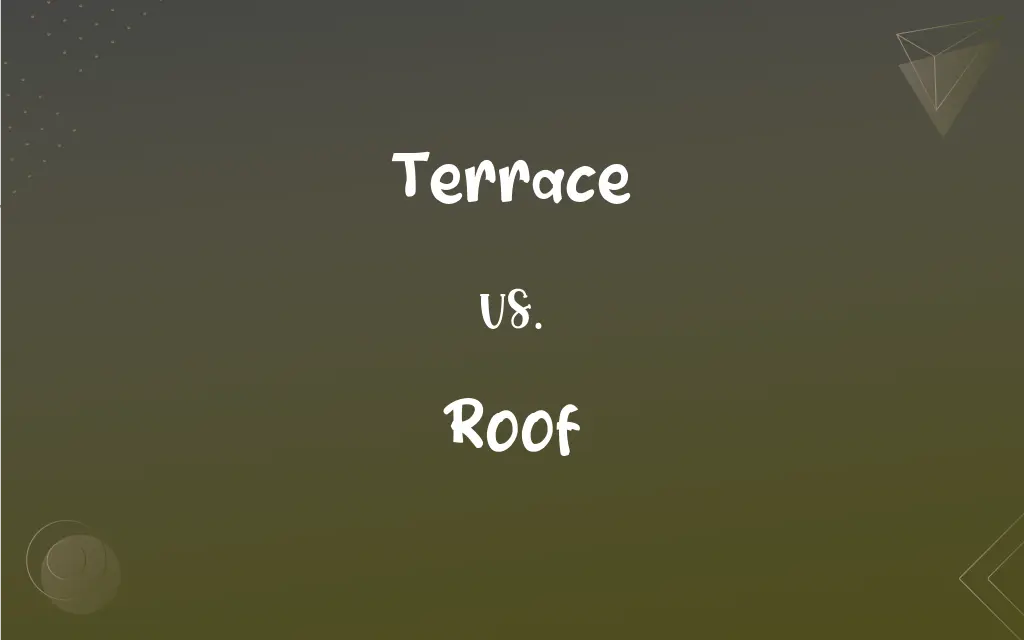Terrace vs. Roof: What's the Difference?
By Aimie Carlson & Harlon Moss || Updated on March 4, 2024
A terrace is an outdoor, flat, open area, often on top of a building, used for leisure or gardening, while a roof is the top covering of a building, designed to protect against weather.

Key Differences
A terrace, typically found on top of buildings or as part of a building's structure, is designed as a flat, open space. It serves various purposes, including leisure activities, dining, gardening, or as an additional outdoor living area. Terraces are often accessible and can be adorned with plants, furniture, and other outdoor amenities. On the other hand, a roof is a fundamental architectural element that forms the topmost covering of a building. Its primary function is to provide protection from the weather, such as rain, snow, sunlight, and wind, ensuring the safety and comfort of the building's occupants.
While a terrace is an optional architectural feature that adds value and space to a building, enhancing its aesthetic appeal and functionality, a roof is an essential component of any building, critical for structural integrity and environmental protection. Terraces are designed with usability and accessibility in mind, promoting outdoor living and offering views of the surrounding area, whereas roofs are engineered to be durable, with materials and designs selected for longevity, insulation, and weather resistance.
The construction of a terrace involves considerations for drainage, accessibility, and load-bearing capacity, ensuring it can support furniture, plants, and people. Materials used in terrace construction may include pavers, wood decking, or concrete, with an emphasis on outdoor durability and aesthetics. Conversely, roofing construction focuses on materials like asphalt shingles, tiles, metal, or slate, chosen for their ability to withstand environmental conditions and provide thermal insulation.
In terms of maintenance, terraces require regular care to keep the space clean, attractive, and functional, including plant care, furniture upkeep, and surface cleaning. Roof maintenance, however, is centered on ensuring the roof remains watertight and structurally sound, involving inspections, cleaning gutters, repairing leaks, and sometimes replacing worn-out materials to prevent damage to the building's interior.
Despite their different purposes and designs, both terraces and roofs contribute significantly to a building's overall character and functionality. A terrace offers a bridge between indoor and outdoor living, providing a space for relaxation and enjoyment in the open air, while a roof plays a crucial role in safeguarding the building and its occupants from external elements, highlighting the diverse yet essential nature of architectural features in creating habitable and enjoyable spaces.
ADVERTISEMENT
Comparison Chart
Purpose
Leisure, gardening, outdoor living
Protection against weather, insulation
Location
On top of buildings, within gardens
Top covering of a building
Accessibility
Designed for people to use and access
Not typically accessible, except for maintenance
Materials
Pavers, wood decking, concrete
Asphalt shingles, tiles, metal, slate
Maintenance
Cleaning, plant care, furniture upkeep
Inspections, cleaning gutters, repairing leaks
ADVERTISEMENT
Design
Flat, open space, often with decorative elements
Engineered for durability, weather resistance, insulation
Functionality
Adds living space and aesthetic value to buildings
Essential for structural integrity and environmental protection
Construction
Focus on drainage, load capacity, and aesthetics
Focus on durability, insulation, and weatherproofing
Terrace and Roof Definitions
Terrace
Can serve as a garden space in urban settings.
She grows vegetables and herbs on her apartment terrace.
Roof
The top covering of a building, providing protection from the elements.
They had to replace the roof after the storm damage.
Terrace
Often designed with accessibility for relaxation and entertainment.
Their terrace includes seating areas and a fire pit.
Roof
Not typically used as a living space, focusing on protection.
Access to the roof is restricted to maintenance personnel only.
Terrace
Requires maintenance to keep the area clean and inviting.
Regular sweeping and plant care keep the terrace in top condition.
Roof
Essential for the structural integrity of a building.
The roof's design contributes to the building's overall stability.
Terrace
A porch or walkway bordered by colonnades.
Roof
The upper exterior surface of a dwelling as a symbol of the home itself
Three generations living under one roof.
Terrace
A platform extending outdoors from a floor of a house or apartment building.
Roof
Designed for durability and insulation.
The new roof includes solar tiles for energy efficiency.
Terrace
An open, often paved area adjacent to a house serving as an outdoor living space; a patio.
Roof
Maintenance is crucial for preventing leaks and damage.
Annual roof inspections help identify potential issues early.
Terrace
A raised bank of earth having vertical or sloping sides and a flat top
Turning a hillside into a series of ascending terraces for farming.
Roof
The exterior surface and its supporting structures on the top of a building.
Terrace
A flat, narrow stretch of ground, often having a steep slope facing a river, lake, or sea.
Roof
The top covering of something
The roof of a car.
Terrace
A row of buildings erected on raised ground or on a sloping site.
Roof
The upper surface of an anatomical structure, especially one having a vaulted inner structure
The roof of the mouth.
Terrace
A section of row houses.
Roof
The highest point or limit; the summit or ceiling
A roof on prices is needed to keep our customers happy.
Terrace
Abbr. Ter. or Terr. A residential street, especially along the top or slope of a hill.
Roof
To furnish with a roof or cover.
Terrace
A narrow strip of landscaped earth in the middle of a street.
Roof
(architecture) The external covering at the top of a building.
The roof was blown off by the tornado.
Terrace
To provide (a house, for example) with a terrace or terraces.
Roof
The top external level of a building.
Let's go up to the roof.
Terrace
To form (a hillside or sloping lawn, for example) into terraces.
Roof
The upper part of a cavity.
The palate is the roof of the mouth.
Terrace
A flat open area on the topmost floor of a building or apartment
Roof
(mining) The surface or bed of rock immediately overlying a bed of coal or a flat vein.
Terrace
A platform that extends outwards from a building.
Roof
(climbing) An overhanging rock wall.
Terrace
(agriculture) A raised, flat-topped bank of earth with sloping sides, especially one of a series for farming or leisure; a similar natural area of ground, often next to a river.
Roof
(transitive) To cover or furnish with a roof.
Terrace
(geology) A step-like landform; (sometimes) remnants of floodplains.
Roof
To traverse buildings by walking or climbing across their roofs.
Terrace
A row of residential houses with no gaps between them; a group of row houses.
Roof
To put into prison, to bird.
Terrace
A single house in such a group.
Roof
(transitive) To shelter as if under a roof.
Terrace
The standing area of a sports stadium.
Roof
The cover of any building, including the roofing (see Roofing) and all the materials and construction necessary to carry and maintain the same upon the walls or other uprights. In the case of a building with vaulted ceilings protected by an outer roof, some writers call the vault the roof, and the outer protection the roof mask. It is better, however, to consider the vault as the ceiling only, in cases where it has farther covering.
Terrace
The roof of a building, especially if accessible to the residents. Often used for drying laundry, sun-drying foodstuffs, exercise, or sleeping outdoors in hot weather.
Roof
That which resembles, or corresponds to, the covering or the ceiling of a house; as, the roof of a cavern; the roof of the mouth.
The flowery roofShowered roses, which the morn repaired.
Terrace
To provide something with a terrace.
Roof
The surface or bed of rock immediately overlying a bed of coal or a flat vein.
Terrace
To form something into a terrace.
Roof
To cover with a roof.
I have not seen the remains of any Roman buildings that have not been roofed with vaults or arches.
Terrace
A raised level space, shelf, or platform of earth, supported on one or more sides by a wall, a bank of tuft, or the like, whether designed for use or pleasure.
Roof
To inclose in a house; figuratively, to shelter.
Here had we now our country's honor roofed.
Terrace
A balcony, especially a large and uncovered one.
Roof
A protective covering that covers or forms the top of a building
Terrace
A flat roof to a house; as, the buildings of the Oriental nations are covered with terraces.
Roof
Protective covering on top of a motor vehicle
Terrace
A street, or a row of houses, on a bank or the side of a hill; hence, any street, or row of houses.
Roof
Provide a building with a roof; cover a building with a roof
Terrace
A level plain, usually with a steep front, bordering a river, a lake, or sometimes the sea.
Terrace
To form into a terrace or terraces; to furnish with a terrace or terraces, as, to terrace a garden, or a building.
Clermont's terraced height, and Esher's groves.
Terrace
Usually paved outdoor area adjoining a residence
Terrace
A level shelf of land interrupting a declivity (with steep slopes above and below)
Terrace
A row of houses built in a similar style and having common dividing walls (or the street on which they face);
Grosvenor Terrace
Terrace
Provide (a house) with a terrace;
We terrassed the country house
Terrace
Make into terraces as for cultivation;
The Incas terraced their mountainous land
Terrace
An open, flat area, usually on a building's top, used for leisure.
The hotel's rooftop terrace offers stunning city views.
Terrace
Adds aesthetic and functional value to buildings.
The building's terrace is a key selling point for potential renters.
FAQs
Can a terrace also serve as a roof?
Yes, a terrace can serve as a roof for the underlying structure, combining the protective function of a roof with the usability of an outdoor living space.
What considerations are important in the construction of a roof?
Important considerations in roof construction include material durability, weather resistance, insulation properties, and ensuring the roof is watertight to protect the building's interior.
What maintenance is required for a terrace compared to a roof?
Terrace maintenance includes cleaning, plant care, and furniture upkeep to maintain its functionality and appearance. Roof maintenance focuses on ensuring the roof remains watertight and structurally sound, including gutter cleaning and leak repairs.
How does a terrace add value to a building?
A terrace adds value to a building by providing additional outdoor living space, enhancing the building's aesthetic appeal, and potentially improving the quality of life for its occupants.
What is a terrace?
A terrace is an open, flat area, often located on the top of a building or within a building's grounds, designed for leisure, gardening, or outdoor living.
What is the purpose of a roof?
The primary purpose of a roof is to protect the building and its occupants from the weather, including rain, snow, sunlight, and wind, while also providing insulation.
Can a terrace improve a property's energy efficiency?
Yes, a terrace can improve a property's energy efficiency by providing additional insulation, reducing heat absorption through the roof, and potentially hosting solar panels or green roofs that contribute to energy savings.
How do materials used in terraces and roofs differ?
Terrace materials are selected for outdoor durability and aesthetics, such as wood decking or pavers, while roofing materials are chosen for weather resistance and insulation, like asphalt shingles or metal.
How do weather conditions affect the lifespan of a roof?
Extreme weather conditions, such as heavy rain, snow, high winds, and intense sunlight, can significantly affect a roof's lifespan by causing wear, damage, and degradation to roofing materials over time.
Is it expensive to add a terrace to an existing building?
Adding a terrace to an existing building can be expensive, as it often requires structural modifications, waterproofing, and compliance with building codes. Costs vary based on size, materials, and design complexity.
Why are roofs designed to be durable?
Roofs are designed to be durable to withstand environmental conditions, protect the building from weather damage, and provide long-term structural integrity and insulation.
How can a terrace be made more private?
A terrace can be made more private with the use of screening plants, privacy screens, trellises, or pergolas, enhancing the sense of seclusion and comfort for users.
Can anyone access a roof for leisure purposes?
Typically, roofs are not designed for general access or leisure purposes, with access restricted to maintenance personnel. However, some buildings may have specially designed rooftop terraces for leisure use.
What are the environmental benefits of a green terrace?
A green terrace, or rooftop garden, offers environmental benefits including improved air quality, reduced urban heat island effect, stormwater management, and increased biodiversity in urban areas.
What safety measures are important for terrace design?
Important safety measures for terrace design include adequate railings, non-slip surfaces, proper lighting, and ensuring the structure can support the intended load, including people, furniture, and plants.
What factors determine the best type of roofing material for a building?
Factors include climate, architectural style, weight capacity of the building, maintenance requirements, and budget. Material choice affects durability, energy efficiency, and aesthetic appeal.
What are the signs that a roof needs replacing?
Signs include significant leaking, widespread staining, missing or damaged shingles, and sagging. If the roof is beyond its expected lifespan, replacement might also be necessary.
What are the legal considerations when adding a terrace or modifying a roof?
Legal considerations include obtaining necessary permits, adhering to local building codes and regulations, respecting zoning laws, and potentially seeking approval from homeowners' associations or similar bodies. Compliance ensures safety, legality, and can affect insurance.
What are the benefits of incorporating a terrace into a building's design?
Incorporating a terrace into a building's design offers benefits such as increased living space, opportunities for outdoor activities, and enhanced building aesthetics, contributing to a more enjoyable living environment.
How often should a roof be inspected?
It's recommended to inspect a roof at least once a year or after any severe weather event. Regular inspections can identify potential issues before they become serious problems.
About Author
Written by
Aimie CarlsonAimie Carlson, holding a master's degree in English literature, is a fervent English language enthusiast. She lends her writing talents to Difference Wiki, a prominent website that specializes in comparisons, offering readers insightful analyses that both captivate and inform.
Co-written by
Harlon MossHarlon is a seasoned quality moderator and accomplished content writer for Difference Wiki. An alumnus of the prestigious University of California, he earned his degree in Computer Science. Leveraging his academic background, Harlon brings a meticulous and informed perspective to his work, ensuring content accuracy and excellence.































































